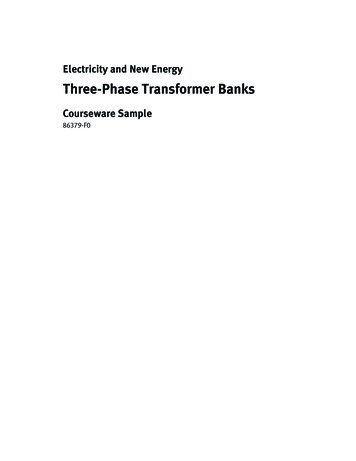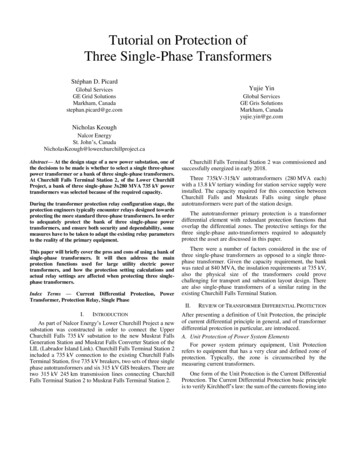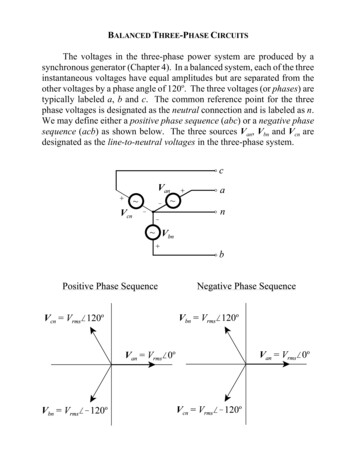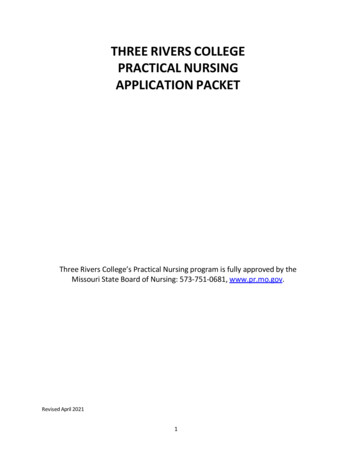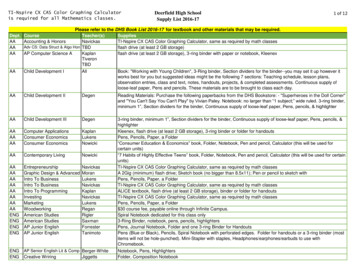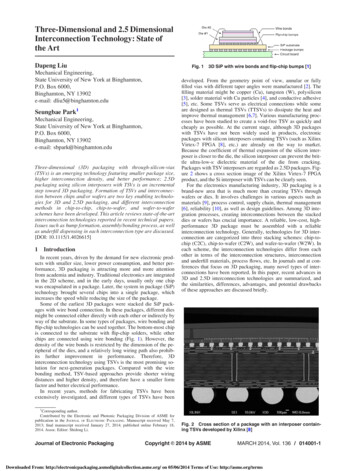
Transcription
Three-Dimensional and 2.5 DimensionalInterconnection Technology: State ofthe ArtDapeng LiuFig. 1Mechanical Engineering,State University of New York at Binghamton,P.O. Box 6000,Binghamton, NY 13902e-mail: dliu5@binghamton.eduSeungbae Park1Mechanical Engineering,State University of New York at Binghamton,P.O. Box 6000,Binghamton, NY 13902e-mail: sbpark@binghamton.eduThree-dimensional (3D) packaging with through-silicon-vias(TSVs) is an emerging technology featuring smaller package size,higher interconnection density, and better performance; 2.5Dpackaging using silicon interposers with TSVs is an incrementalstep toward 3D packaging. Formation of TSVs and interconnection between chips and/or wafers are two key enabling technologies for 3D and 2.5D packaging, and different interconnectionmethods in chip-to-chip, chip-to-wafer, and wafer-to-waferschemes have been developed. This article reviews state-of-the-artinterconnection technologies reported in recent technical papers.Issues such as bump formation, assembly/bonding process, as wellas underfill dispensing in each interconnection type are discussed.[DOI: 10.1115/1.4026615]1IntroductionIn recent years, driven by the demand for new electronic products with smaller size, lower power consumption, and better performance, 3D packaging is attracting more and more attentionfrom academia and industry. Traditional electronics are integratedin the 2D scheme, and in the early days, usually only one chipwas encapsulated in a package. Later, the system in package (SiP)technology brought several chips into a single package, whichincreases the speed while reducing the size of the package.Some of the earliest 3D packages were stacked die SiP packages with wire bond connection. In these packages, different diesmight be connected either directly with each other or indirectly byway of the substrate. In some types of packages, wire bonding andflip-chip technologies can be used together. The bottom-most chipis connected to the substrate with flip-chip solders, while otherchips are connected using wire bonding (Fig. 1). However, thedensity of the wire bonds is restricted by the dimension of the peripheral of the dies, and a relatively long wiring path also prohibits further improvement in performance. Therefore, 3Dinterconnection technology using TSVs is the most promising solution for next-generation packages. Compared with the wirebonding method, TSV-based approaches provide shorter wiringdistances and higher density, and therefore have a smaller formfactor and better electrical performance.In recent years, methods for fabricating TSVs have beenextensively investigated, and different types of TSVs have been1Corresponding author.Contributed by the Electronic and Photonic Packaging Division of ASME forpublication in the JOURNAL OF ELECTRONIC PACKAGING. Manuscript received May 7,2013; final manuscript received January 27, 2014; published online February 18,2014. Assoc. Editor: Shidong Li.Journal of Electronic Packaging3D SiP with wire bonds and flip-chip bumps [1]developed. From the geometry point of view, annular or fullyfilled vias with different taper angles were manufactured [2]. Thefilling material might be copper (Cu), tungsten (W), polysilicon[3], solder material with Cu particles [4], and conductive adhesive[5], etc. Some TSVs serve as electrical connections while someare designed as thermal TSVs (TTSVs) to dissipate the heat andimprove thermal management [6,7]. Various manufacturing processes have been studied to create a void-free TSV as quickly andcheaply as possible. At the current stage, although 3D packageswith TSVs have not been widely used in products, electronicpackages with silicon interposers containing TSVs (such as XilinxVirtex-7 FPGA [8], etc.) are already on the way to market.Because the coefficient of thermal expansion of the silicon interposer is closer to the die, the silicon interposer can prevent the brittle ultra-low-j dielectric material of the die from cracking.Packages with TSV interposers are regarded as 2.5D packages. Figure 2 shows a cross section image of the Xilinx Virtex-7 FPGAproduct, and the Si interposer with TSVs can be clearly seen.For the electronics manufacturing industry, 3D packaging is abrand-new area that is much more than creating TSVs throughwafers or dies. It involves challenges in various aspects such asmaterials [9], process control, supply chain, thermal management[6], reliability [10], as well as design guidelines. Among 3D integration processes, creating interconnections between the stackeddies or wafers has crucial importance. A reliable, low-cost, highperformance 3D package must be assembled with a reliableinterconnection technology. Generally, technologies for 3D interconnection are categorized into three stacking schemes: chip-tochip (C2C), chip-to-wafer (C2W), and wafer-to-wafer (W2W). Ineach scheme, the interconnection technologies differ from eachother in terms of the interconnection structures, interconnectionand underfill materials, process flows, etc. In journals and at conferences that focus on 3D packaging, many novel types of interconnections have been reported. In this paper, recent advances in3D and 2.5D interconnection technologies are summarized, andthe similarities, differences, advantages, and potential drawbacksof these approaches are discussed briefly.Fig. 2 Cross section of a package with an interposer containing TSVs developed by Xilinx [8]C 2014 by ASMECopyright VMARCH 2014, Vol. 136 / 014001-1Downloaded From: sme.org/ on 05/06/2014 Terms of Use: http://asme.org/terms
2Chip-to-Chip and Chip-to-Wafer InterconnectionCurrently, chip-to-chip (also known as die-to-die or D2D insome literature) stacking is being widely researched in 3D interconnection. In this stacking scheme, although the TSVs are usually fabricated at the wafer level, the wafer is diced into chipsbefore the stacking process. This technology not only minimizesthe change in bonding tools but also ensures that only “knowngood dies” (KGDs) are used in the assembly, which leads to ahigh yield. Chip-to-chip stacking is a very flexible technology,and chips with different sizes can be integrated in one package.Chip-to-wafer (also known as die-to-wafer, D2W) approachesmay also share these advantages. The difference is, in the chip-towafer approach, the chips are connected to the wafer, and the singulation of each stack is performed after the assembly, or even after the underfill dispensing and molding process [11]. Multiplechips can be bonded to a temporary carrier and then assembled tothe wafer simultaneously. Therefore, chip-to-wafer stacking canachieve higher throughput than chip-to-chip stacking. In addition,a specially designed template can be used as the carrier to improvethe precision of the alignment [12]. In recent years, there havebeen numerous advances in chip-to-chip and chip-to-waferapproaches, many of which use fine-pitch microbumps or Cu pillars for interconnection and adopt improved underfill dispensingtechnologies.2.1 Bump Structure. Various interconnection types with different materials, sizes, and even structures have been reported inrecent years. Common interconnection structures such as microbumps and Cu pillars have been used in 3D chip-stacking structures [13–22]. Generally, the trend of the interconnection isbecoming smaller in dimension, finer in pitch, and higher in interconnection density. Bumps with 10 lm pitch have already beenstudied [14]. Some innovative bump structures invented in recentyears, such as the Ni micro-insert [23–25] and the Cu/Sn interlocking bump [26,27], have also been applied to 3D interconnections. Figure 3 shows a cross section view of interlocking bumpsfabricated by Jang et al. [28]. Sn bumps (25 lm in diameter and15 lm high) were fabricated on one chip, and the Cu interlockingbumps on the other chip were inserted into the larger Sn bumpsusing the flip-chip bonding process. Planar bumps (70 lm in diameter and 10 lm high) directly fabricated on Cu TSV were alsoused in the same paper (Fig. 3). Souriau et al. used micro-insertinterconnection technology in their chip-to-wafer stacking study[29]. In that process, a matrix of micro-inserts made of Ni wasinserted in the soft NiSn material, which was formed on the corresponding location on the wafer (or on other dies). An image of themicro-inserts matrix is shown in Fig. 4. These novel structureshave several benefits. First, they meet the trend of miniature in thepackaging industry and enable high-density interconnection, oneof the driving forces of TSV-based 3D integration. Small bumpsize not only reduces the distance between dies but also leavesmore space on the die so that more TSVs can be fabricated. Second, these structures are compatible with mature flip-chip bondingtechniques for chip-to-chip or chip-to-wafer connections. In addition, the mechanical robustness and electrical performance haveFig. 4Image of fabricated micro-inserts [29]been tested by the inventors [28,30]. Some disadvantages of thesenovel structures have also been pointed out in publications. Forinstance, the micro-insert approach is sensitive to planarity, andnonflatness may increase electrical resistivity [23].The Cu pillar bump technology has emerged in recent years.This technology enables small pitch size and high interconnectiondensity. Compared with the solder-bump-based interconnection, aCu pillar with a solder cap has many advantages such as higherstandoff, less solder spread out [31,32], etc. Though this technology was invented not long ago, it has already been used in 3D/2.5D packaging [19,33], and the effect of solder capping materialhas been studied [34]. Direct Cu to Cu bonding using the thermocompression method, which can connect two Cu pillars (or studs)without using any solder material, has also been researched[35,36].2.2 Bumping and Assembly Process. Formation of thebumps or pads is an important step in the packaging process. Various bumping methods have been investigated to make the processmore efficient and reliable.The controlled collapse chip connection (C4) technology,which was invented by IBM in the 1960s, is a well-establishedinterconnection technology. Different methods of making C4bumps, such as masked evaporation [37], paste screening [38],and photolithographic electroplating [39], have been developedsince its invention. A current C4 bumping technology developedby IBM, the C4-New Process (C4NP), has already been used in3D chip-stacking [21,22,40]. The C4NP process utilizes a glassmold with cavities to transfer solder to the wafer. Molten solder isinjected in the cavities of the mold, and then the mold is alignedbelow the wafer. Then, the wafer and the mold are heated abovethe solder’s melting temperature in a sealed-off manufacturingenvironment so that the solder will wet the underbump metallization (UBM) and attach to the wafer. The C4NP process flow isschematically depicted in Fig. 5. Compared with other bumpingmethods, this approach combines several advantages, such as thecapability of fabricating fine-pitch bumps in volume production,easy change of solder materials, environmentally friendly manufacturing (no plating chemical), low cost, etc. [40].Due to the capability to fabricate tiny bumps, plating is anotherpopular method for bumping and forming UBM. Electrolytic andFig. 3 Cross section image showing interlocking Sn/Cu bumps (left) and a Cuplanar bump with TSVs (right) [28]014001-2 / Vol. 136, MARCH 2014Transactions of the ASMEDownloaded From: sme.org/ on 05/06/2014 Terms of Use: http://asme.org/terms
Fig. 5Solder transfer process in C4NP technology [21]electroless plating processes are widely used; for example, Cu pillars with different solder caps can be formed by electroplating[41]. Reflow and plasma cleaning that removes contamination andthe oxidation layer might be conducted after plating [42]. Variousdeposition methods are also commonly used. For example, inSouriau et al.’s micro-inserts approach, the Ni and NiSn layerswere formed by the electroplated chemical deposition method ona Ti/Cu seed layer, while the seed layer was deposited by physicalvapor deposition [29].The conventional approach for making TSVs includes a process(usually chemical–mechanical planarization, CMP) for removingthe overburden Cu. However, a recent study has shown that byimproving the TSV filling process, the Cu microbumps on theactive side of the TSV can be directly formed by the electroplatingmethod in the TSV-filling process, so there is no need to removeCu and perform extra bumping on that side [43]. The TSVs andCu microbumps fabricated by this novel process are shown inFig. 6.A solder bump maker (SBM) technology that does not requiresolder mask has also been reported [44–46]. The SBM is made upof resin, additives, and Sn58Bi solder powder. A guide is used tocontrol the thickness of the SBM layer, and excessively printedSBM materials are removed with a blade. Then, the guide isremoved, the chip is reflowed, and the bumps are formed. A coining process is applied to guarantee the uniformity of the height bycompressing the bumps at elevated temperature. The SBM bumpshave low volume and can be formed directly on top of the TSVs.The schematic diagram of the bumping process is shown in Fig. 7,and a cross section image of the bumps after the coining processis shown in Fig. 8.New interconnection materials and bonding techniques areemerging, and various new processes have been developed. Traditional flip-chip bonding approaches and many novel technologieshave been introduced in the 3D chip-to-chip or chip-to-waferpackaging area.Fig. 6 Cross section image of Cu-filled TSV with Cumicrobump (a) and X-ray photo of TSVs after Sn plating (b) [43]Journal of Electronic PackagingFig. 7 Schematic diagram of the SBM bumping process [45]Fig. 8[44]Cross section image showing TSVs and coined bumps2.2.1 Bonding With C4 Reflow Process. Due to numerousadvantages such as low cost and the ability to rework, C4 is a verysuccessful technology widely used in flip-chip packaging. Sinceflip-chip bonding techniques were used in 3D chip stacking, C4interconnections in 3D chip-stacks have also been studied[15–18,21,22]. In the C4 assembly approach, solders are fabricated on the chip, and then the chip is positioned and placed onthe substrate. Finally, the interconnection is created by a reflowprocess.Reflow is one of the most important steps in the C4 process.For 3D assembly, multiple chips must be stacked one overanother, and two different joining strategies may be used. Oneway is to use sequential reflow. In sequential reflow, the bottomchips are mounted first, followed by a reflow process. Then, otherchips are assembled sequentially from the bottom to the top, andthe reflow process is repeated after each chip is mounted. In parallel reflow, an alternative approach, several chips are mounted together, and then all the chips are joined in a single reflow process.Parallel reflow leads to higher manufacturing throughput; however, this approach requires better control of the placement process, because the solder bumps are not connected until reflow. Incontrast, for sequential reflow, the relative displacement betweeneach layer can be controlled in each joining process, at the cost oftime and the risk of dissolving more UBM material in the solder[21]. Both approaches have been successfully implemented inexperiments, and a three-layer stack by IBM using sequentialreflow is demonstrated in Fig. 9.As the size of the microbumps decreases, flux cleaningbecomes more and more difficult, especially for large dies. TwoMARCH 2014, Vol. 136 / 014001-3Downloaded From: sme.org/ on 05/06/2014 Terms of Use: http://asme.org/terms
Fig. 9 A three-layer chip-stack fabricated with sequentialreflow process by IBM [17]approaches have been studied to resolve this issue. One improvesthe flux-cleaning tools or processes, and the other approach adoptsa fluxless bumping method. Au et al. applied an additional forceflow system to the inline pressurized spray system in theirresearch, and a test on a four-layer stacked-chip module with a30 lm gap showed that the force-flow system is four times moreefficient than inline pressurized spray only [15]. Maria et al. triedtwo approaches: a fluxless bonding approach with formic acid ambient and flux bonding with a water-soluble flux. Both led to successful results [18].2.2.2 Bonding With Thermocompression. In the thermocompression method, interconnection materials are pressed together atelevated temperature to form the joints. The process temperatureand pressure depend on the material and geometry of the joints.Various studies have been conducted on creating interconnectionsbetween stacked strata using thermocompression. For instance,micro-inserts and interlocking bump structures (Sec. 2.1) havebeen assembled in this way [28,29]. The thermocompressionmethod does not require the reflow process and has been used tocreate tiny, fine-pitch interconnections [13]. Zhan et al. comparedtwo thermocompression bonding methods: conventional thermocompression in which the top chip was compressed continuouslyand gap-control thermocompression containing two separate compressions, while each compression had its own pressure and duration value. The experiment showed that novel gap-controlbonding might prohibit the solder squeezing issue and lead to better bonding results [42].Direct Cu–Cu bonding with thermocompression offers severalbenefits such as low electrical resistivity, high thermal conductivity, and low susceptibility to electromigration. Key parameters ofthis process include temperature, pressure, duration, and surfacecleanness of Cu [47]. The variation of Cu pillar/pad height is aconcern, and a method for compensating the bump height variation was proposed by Lee et al. using electroless Ni plating [35].In Lee et al.’s approach, the Cu pillars and Cu studs were formedon two chips. After bonding with thermocompression, the bondedparts were put through cleaning, surface roughening, catalyst andconditioning process, and then immersed in the Ni-P solution forplating. As a result, the electroless plating process led to improvedinterconnection quality by filling the gap between the Cu pillarsand the studs, thus reducing the resistance by 15%.2.2.3 Low-Temperature Interconnection Methods. In additionto traditional thermocompression and reflow soldering processes,novel low-temperature interconnecting processes have also beendeveloped [48]. In C2C and C2W approaches, low-temperaturesoldering processes such as the transient liquid phase (TLP) andsolid state diffusion bonding usually feature a low melting point atbonding but a high remelting temperature due to the formation ofan intermetallic layer. These methods may greatly reduce the temperature required at assembly, and therefore reduce the stressinduced by thermal mismatch. Bonding materials reported in theliterature include InSn by Morinaga et al. [49], AuInSn by Xie014001-4 / Vol. 136, MARCH 2014et al. [50], CuSn by Zhang, Agarwal et al. [51,52] and Sakumaet al. [53], CuInNi by Sakuma et al. [53], etc. Agarwal et al. usedtwo relatively low-temperature processes for the CuSn material,TLP and solid metal bonding (SMB). The SMB bonding has alower processing temperature than TLP, which is below the melting point of Sn [51]. Sakuma et al. compared the reliability ofCuInNi and CuSn bonding with finite element analysis (FEA) andexperiments, and results indicated that the NiCuIn solder showedbetter thermomechanical reliability than the CuSn solder. Different failure modes were associated with two material combinations. For CuInNi, the failure was found on In; while for CuSn,failures such as die-cracking were found [53].One point worth mentioning is that the advantage of these lowtemperature bonding methods is not just low-temperature processing. The trends in the packaging industry are higher density, morecontrollable processes, higher thermomechanical reliability, andthese goals have been achieved by these novel approaches. Forexample, in Ref. [53], low-volume CuNiIn solder only 6 lm highwas successfully made on an annular, tungsten-filled TSV, and thesamples exhibit good reliability in the thermal cycling tests.2.3 Issues on Underfill. Underfill is a key technology forimproving the thermal–mechanical reliability of flip-chip packages. Many variations of underfill have been developed toincrease reliability, simplify the process, achieve higher yield, andreduce the voids [54]. As the industry began to use flip-chip technologies to create the chip-stacking structure, this reliabilityenhancing technology was applied to 3D packaging as well. However, as the distances between chips decrease, dispensing underfillis becoming more challenging. Yet many researchers have successfully dispensed the underfill into the small gaps [15,16,18,53].Au et al. filled all the gaps in a four-die stack package through amultiple line/multiple needle height dispensing process, so thatthe encapsulation of all gaps between the joints can be donesimultaneously [15]. Au et al. also found that the corner filletvalue of conventional filling would expose the top-most solderjoint gap interface (Fig. 10). In contrast to the traditional capillaryunderfill process in which the flow of underfill is driven by thesurface tension, a vacuum filling approach was developed byresearchers at IBM [18,55]. In the vacuum filling approach, theflow of underfill is driven by the pressure difference, and thischange in the dispensing mechanism led to better filling quality. Ascanning acoustic microscope (SAM) image shows that the vacuum filling technology can fill a 14 lm gap without leaving a visible void in the underfill, while in its counterpart, the small voidsappear clearly in the SAM image (Fig. 11).Instead of dispensing underfill after stacking, another approachuses no-flow underfill or adhesive to fill the gaps between thechips. No-flow underfill is dispensed before the chip-attachmentprocess and cured after the assembly. The solder reflow and cureprocess can be integrated, leading to a more efficient manufacturing process. Adhesive materials that are pre-applied before the assembly process may serve a similar function as underfill;therefore, in this paper, the term “simultaneous underfill” is usedto describe the materials that fill the space between Si chips orwafers simultaneously with the assembly process.Fig. 10 A gap exposed by using a typical 50% corner filletvalue in underfill dispensing [15]Transactions of the ASMEDownloaded From: sme.org/ on 05/06/2014 Terms of Use: http://asme.org/terms
Fig. 11 SAM image of flip-chip samples after capillary (left)and vacuum (right) underfill dispensing [55]Myo et al. combined In-based low temperature with no-flowunderfill [56]. In that study, the chip-stacking structure was fabricated by attaching the chips sequentially. In each step, the underfill was dispensed onto the substrate (or lower chips), and then thechip was placed and bonded. A similar underfill approach wasperformed by Agarwal et al. in low-temperature chip-to-waferbonding with CuSn microbumps [51].Hybrid bonding using metallic materials for interconnectionand adhesive materials as simultaneous underfill has also beeninvestigated. For example, the Cu/Sn interlocking bump technology in Sec. 2.1 uses adhesive to fill the gap and secure the structure [28]. Some scholars use the term “wafer-level underfill”(WLUF) for the pre-applied material on the wafer that glues thechips or wafers together in the assembly process and serves thesame function as regular underfill afterward [54]. In the manufacturing process with wafer-level underfill, the bumping is performed at the wafer level, and then the wafer-level underfill isapplied on the wafer, usually by spin coating (or vacuum lamination, screen printing, stencil printing). A B-stage cure process follows if the underfill is initially in a liquid state. Then, the wafer isdiced for assembly if chip-to-chips or chip-to-wafer stacking isused [57].The resin or filler on the bump surface is a problem that potentially affects the connection. To get rid of these materials, hybridbonding technology with a planarization process was developed.The planarization process is usually CMP or diamond bit cutting.Nimura et al. developed a low-cost thermal pressure planarizationprocess. In their approach, the resin was compressed by a siliconsubstrate coated with a release agent. The solder/adhesive and Au/adhesive bonding were successfully implemented after this novelplanarization process [58–60].Because of the difficulty in underfill dispensing, 3D chipstacking structures without underfill were also studied [34,61].Researchers have used FEA and experimental methods to studythe reliability of 3D packages with and without underfill materials.Although producing packages without underfill is usually notpreferable, in some cases the reliability appears acceptable. Forexample, Kohara et al. showed that samples with a thin die(50 lm or 70 lm thick, 7.3 mm by 7.3 mm chip area) connected toa silicon interposer by 40 lm pitch solder joints could survive1000 thermal cycles even without underfill. However, with a thickdie (725 lm thick with the same chip area), the parts failed shortlyafter the test, but the parts with underfill passed. Finite elementsimulation reached consistent results with the reliability test [61].Therefore, experiments must be performed to carefully evaluatethe reliability, and numerical simulation is also suggested.3decreases as the number of stacked layers increases. The costeffectiveness of wafer-to-wafer stacking has been analyzed andcompared with the chip-to-wafer approach [62,63]. On one hand,the analysis in Ref. [63] shows that either chip-to-wafer or waferto-wafer stacking might be more cost-effective, depending on thechip area and production volume; on the other hand, for the wafer-to-wafer approach, low yield could greatly increase the costdue to the loss of good dies, especially for large chips [64].Due to the dimension of the wafer, dispensing underfill into thenarrow gaps between wafers is very difficult, if not impossible.And even after wafer-dicing, filling underfill into the narrow gapsinside the chip-stacks is still challenging (Sec. 2.3). Therefore,recent studies of wafer-to-wafer interconnection focus on processes using simultaneous underfill or techniques that do not necessitate underfill at all [65].3.1 With Simultaneous Underfill. The simultaneous underfill approach is an emerging technology that has attracted manyresearchers. Once the bonding process is finished, the gap betweenwafers is occupied by the filled materials simultaneously, and thefilled materials act as a stress-redistribution layer to alleviate thereliability risk at the electrical joints. Depending on the interconnection structure and the TSV formation process, wafer-to-waferbonding with simultaneous underfill can be divided mainly intotwo categories: One is the metal bump interconnection with adhesive or polymer as simultaneous underfill, and the other is adhesive bonding followed by the TSV formation process, which issupported by the wafer-on-wafer (WOW) Alliance and alsoknown as the WOW approach.Hybrid bonding combines the interconnection process of metalbumps with simultaneous adhesive attachment between wafers.Therefore, the adhesive acts as both bonding material and“underfill.” A great advantage of hybrid bonding is that the oldtechnologies and experiences for creating metal-to-metal joint canbe applied to this new method. Ko et al. and Chang et al. workedon the wafer-to-wafer hybrid bonding with CuSn and benezocyclobutene (BCB) [66,67], and the process flow is shown inFig. 12. The Cu bumps were formed on the top wafer, and theCuSn bumps were fabricated on the bottom wafer. Then, the BCBadhesive were applied to both wafers by spin-coating and lithography, followed by a postlithographic treatment process for cleaningthe bump surface. The bonding process was carried out at 250 C.The wafer-thinning and backside metallization were conducted after the bonding. Unlike other wafer-handling processes thatrequire temporal bonding to silicon or glass carrier, this approachfeatures a carrier-less wafer-handling process that can simplify theprocess flow. Cross-sectional scanning electron microscopeWafer-to-Wafer InterconnectionUnlike chip-to-chip or chip-to-wafer stacking, the wafer-to-wafer process is performed completely at the wafer level, and onlyone singulation process is performed after all wafer-stacking stepshave been completed. In this aspect, the wafer-to-wafer processhas a high manufacturing throughput. However, the problem withthe wafer-to-wafer approach is yield. Because there is no way tocherry-pick the KGDs, the yield for wafer-to-wafer stacking islower than chip-to-chip or chip-to-wafer stacking, and the yieldJournal of Electronic PackagingFig. 12 Schematic diagram of the process flow of wafer-to-waferhybrid bonding [66]MARCH 2014, Vol. 136 / 014001-5Downloaded From: sme.org/ on 05/06/2014 Terms of Use: http://asme.org/terms
Fig. 13 Cross section images of TSVs and microbumps [67](SEM) images showing the TSVs and microbumps are given inFig. 13.In addition to forming interconnections with eutectic soldermaterials, the Cu–Cu [47,68–70] or Au–Au [59,60] connectionprocess with adhesive (also known as transfer-join process or TJ)has also been developed. IBM researchers fabricated joints with amechanical lock-and-key structure using this process. In the structure shown in Fig. 14, a Cu stud was made on the top wafer, and arecess was made on the bottom wafer. A polyimide (PI) layer wascoated on the top wafer. After t
2 Chip-to-Chip and Chip-to-Wafer Interconnection Currently, chip-to-chip (also known as die-to-die or D2D in some literature) stacking is being widely researched in 3D inter-connection. In this stacking scheme, although the TSVs are usu-ally fabricated at the wafer level, the wafer is diced into chips before the stacking process.
